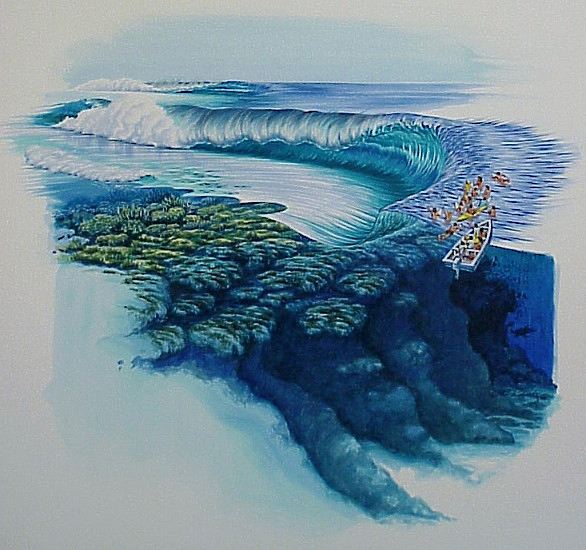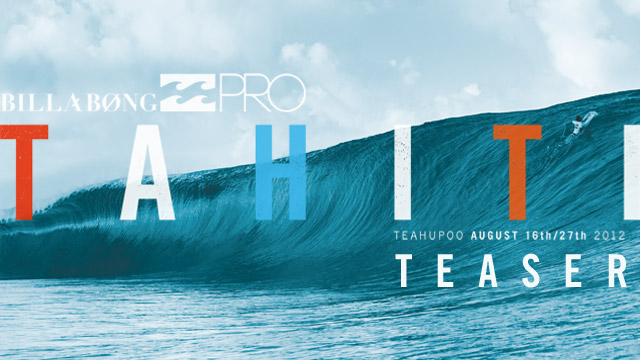This week coming sees stop number 5 of the ASP World Championship Tour, the Billabong Pro Tahiti. One of the most anticipated contests of the year, it runs from August 16-27, at the heaving South Pacific reef pass of Teahupoo. This infamous event puts the world’s best surfers up against some of the biggest and most powerful waves on the planet.
At the moment, the top 5 surfers on the ASP World Championship Tour are separated by less than 4000 points (with 10,000pts awarded for an event win), so a win here at the mid-way point of the season could be a great boost into the latter half of the year.
Historically, it’s one of the most unpredictable events. Where we often see the favorites knocked out in the early rounds, broken boards, broken bones and dark horses surprising everyone. This contest is very different from most other events on tour, as the emphasis from the judges is not on performing turns and maneuvers, but on the surfers ability to ride in the barrel. A test of commitment, strength and skill that separates the men from the boys. It’s often the guys who put in the most time surfing this wave that do well at this event. You can find a few tips on surfing this South Pacific monster from local Tahitian surfer Michel Bourez here.
 The reason Teahupoo has it’s fierce reputation of being one of the world’s heaviest waves comes from the interesting bathymetry (the shape of the sea floor) of it’s coastline. A barrier reef that formed over millions of years surrounds the island, this tropical coral can only exist in relatively shallow water (as it needs to photosynthesize). The reef then descends very fast into deeper water, an almost 150ft vertical drop. The ocean floor around Teahupoo continues to drop even further to more than 1,000ft deep at just 1/3 of a mile offshore. Due to this, any approaching swell meets very little underwater resistance.
The reason Teahupoo has it’s fierce reputation of being one of the world’s heaviest waves comes from the interesting bathymetry (the shape of the sea floor) of it’s coastline. A barrier reef that formed over millions of years surrounds the island, this tropical coral can only exist in relatively shallow water (as it needs to photosynthesize). The reef then descends very fast into deeper water, an almost 150ft vertical drop. The ocean floor around Teahupoo continues to drop even further to more than 1,000ft deep at just 1/3 of a mile offshore. Due to this, any approaching swell meets very little underwater resistance.
The steepness of a breaking wave is determined by the steepness of the ocean floor. For example; a typical beachbreak will have an average steepness ratio of 1:40. Teahupoo on the other hand, has an approximate steepness ratio of 1:2. This means that the swell unloads with all of it’s power, in the form of a gaping barrel, which breaks in about 5ft of water, over the razor sharp reef. There is a reason that the name Teahupoo means ‘…end of the road’. You do not want to fall off here!
Last year saw one of the biggest swells ever ridden at Teahupoo. With the waves over 40ft on the face, the call was made on the morning of August 27th by the contest directors, to put the event on hold until conditions calmed down a little. Enter the big wave free surfers, like the guys you see on Riding Giants. What followed went down in history as one of the most epic days of big wave surfing. As the waves were too big to paddle into, surfers were being towed in by jet-skis. Most of the Tour surfers sat on the side lines and watched as the worlds best big wave surfers stepped up. Billabong put on a live webcast so the World could watch some of the heaviest waves ever ridden, and some of the worst wipeouts ever seen. You can see footage of that unbelievable day in the Billabong video ‘CODE RED‘.
This years forecast, although still a little early, isn’t showing signs of the same epic conditions as last year. Official forecasters for the Billabong Pro Tahiti, Surfline, are calling for a small start to the contest waiting period. Even still, we’ll be sitting back here at Peaks n Swells, tuning in to watch the world’s best surfers battle it out in the South Pacific.
Written by Peaks n Swells Surf Coach Martin Reynolds

